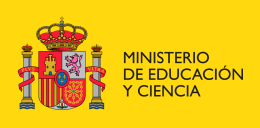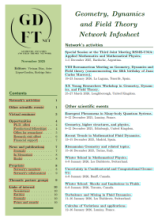Activity
Introduction:
The goal of this meeting is to bring together young researchers working in geometric mechanics and control theory and to offer a platform to present the results of their research to an international audience.
Attendance is, of course, open to anyone, but in particular young researchers (PhD-students, recent PhD's) are encouraged to deliver a talk at this meeting.
The following is a non-exhausted list of topics that can be covered during the workshop:
- Geometry: (multi)symplectic geometry, Poisson and Jacobi manifolds, Lie groups, Lie algebroids and Lie groupoids.
- Mechanics: Lagrangian and Hamiltonian systems, non-holonomic mechanics, calculus of variations, mechanical systems with symmetry, conservation laws and reduction, classical field theories, geometric integration of mechanical systems, geometric quantization.
- Control: optimal control theory, control of mechanical systems, geometric control.
Courses:
Plenary Lectures
Dynamics of a nonhomogeneous rolling ball and its impulsive control [Notas en PDF]
Sebastián Ferraro, Universidad Nacional del Sur
We will consider a ball with two of its three moments of inertia equal, rolling on a plate without slipping or spinning. This nonholonomic system turns out to be equivalent to an ODE on S^2xS^1, for each fixed value of the energy. Its solutions are periodic, and the ball describes a wavy trajectory on the plate. In addition, we will consider the purely kinematic problem of finding the shortest trajectory on the plate that the ball must follow in order to attain a desired final configuration (location and orientation). Finally, we will study the problem of approximating this optimal solution with an impulsive control. This means that the ball is subjected to a number of instantaneous elastic impacts, between which it follows its natural wavy trajectory. We will estimate the error in the final reorientation and discuss some difficulties that arise if one tries to achieve the exact final reorientation.
Hamiltonization in non-Holonomic Mechanics [Notas en PDF]
Luís García Naranjo, École Polytechnique Fédérale de Lausanne
One of the key features that renders the study of nonholonomic mechanics challenging and open is that the equations of motion are not Hamiltonian. Much of the current research in the field consists in studying possible similarities between nonholonomic systems and ordinary Hamiltonian systems, e.g. relations between symmetries and conserved quantities, reduction, existence of invariant measures, complete integrability.
A nonholonomic mechanical system with symmetries is said to be Hamiltonizable if the reduced equations of motion can be given a Hamiltonian structure (possibly after a time reparametrization). The main result in this direction is Chaplygin's reducibility theorem that only applies to systems with two degrees of freedom.
The first part of the lecture will be a summary of some standard results in nonholonomic mechanics including Chaplygin's reducibility theorem. In the second part of the exposition I will give an overview of recent work with S. Hochgerner by showing how the Hamiltonization of the classical problem of a ball rolling without slipping on the table already calls for the introduction of new interesting geometric ideas.
Discrete geometric control and global motion planning [Notas en PDF]
Marin Kobilarov, California Institute of Technology
The talk presents a general computational framework for controlling simple mechanical systems such as a wheeled robot, a boat, a snakeboard, or a simplified helicopter. The first half of the talk considers the derivation of state-space structure respecting integration and optimization schemes for systems with symmetries, controllable shape dynamics, and nonholonomic constraints based on the theory of discrete mechanics. The second part is concerned with the computation of globally optimal motions for such control systems in state spaces with complex structure and non-trivial boundaries, e.g. arising from configuration space obstacles. The proposed approach is based on approximating the reachable space through a network of discrete trajectories, termed "roadmap", that achieves global state space exploration. The discrete trajectories consist of locally optimal segments constructed through the proposed discrete geometric framework. Near-globally optimal motions are then efficiently computed using graph-theoretic dynamic programming methods in the roadmap framework.
Applications of the inverse problem of Lagrangian mechanics [Notas en PDF]
Tom Mestdag, University of Ghent
I will start with a review of the so-called inverse problem of the calculus of variations. This concerns the existence of a regular Lagrangian whose Euler-Lagrange equations are equivalent to a given system of second-order ordinary differential equations. Next, I will investigate two (unrelated) issues in detail.
[1] For the particular case where the configuration space is a Lie group, I will examine the question of when there exists an invariant Lagrangian. Although I will deal with the problem directly on the tangent manifold of the Lie group, the main result relies on a reduction of the invariant system to a system on the Lie algebra of the group. I will show that some cohomology conditions need to be formulated in order to guarantee invariance of the Lagrangians, if they exist.
[2] The idea for the second application is to reformulate a question that arises naturally in the context of non-holonomic mechanics, namely the construction of the constrained equations of motion from an unconstrained Hamiltonian system on the full phase space, in terms of an inverse problem, by focusing first on obtaining an appropriate unconstrained Lagrangian picture. For a certain class of non-holonomic systems, I will search among all possible second-order systems which restrict to the given dynamics on the constraints, for an appropriate one which is variational.
The talk will be based on two of my recent papers:
[1] M Crampin and T Mestdag, The inverse problem for invariant Lagrangians on a Lie group, J of Lie Theory 18 (2008), 471-502.
[2] AM Bloch, OE Fernandez and T Mestdag, Hamiltonization of nonholonomic systems and the inverse problem of the calculus of variations, preprint (2008).
The Marle-Guillemin-Sternberg form. What is it and how to use it [Notas en PDF]
Miguel Rodríguez Olmos, University of Manchester
The MGS form is a fundamental tool for dealing with equivariant problems in symplectic geometry. It provides a (semi) local model of a Hamiltonian G-space (symplectic manifold endowed with a Hamiltonian action of a Lie group) near a group orbit by means of a symplectic tubular neighborhood in which the momentum map is put into normal form. It's applicability range includes virtually every problem involving local properties of Hamiltonian actions. In this talk we will review its construction and will focus in showing the power of this tool in applications. In particular I will explain how to use the MGS form to prove the stratification theorem of singular symplectic reduction. If time allows, I will also show how the MGS normal form gives a simple proof of a classic result of Arnold, which states that a non degenerate relative equilibrium of s a symmetric Hamiltonian system persists to all nearby level sets of the momentum map.
Geometric Methods in Fluid Dynamics [Notas en PDF]
Joris Vankerschaver, California Institute of Technology
The purpose of this lecture is to explain symplectic reduction using the simple, but non-trivial example of a rigid body immersed in a perfect fluid. As such, my lecture consists of two main parts. The first part is a tutorial explaining some introductory concepts from fluid dynamics and their relation with geometric structures. My exposition will be centered around Arnold's insight that the motion of a perfect fluid is determined by a geodesic on the diffeomorphism group, and that the Euler equations arise from this system through Lie-Poisson reduction. In the process, we'll see how classical concepts from geometric mechanics, such as co-adjoint orbits, momentum maps, mechanical connections, etc. all have a natural interpretation in fluid dynamics.
In the second part of the lecture I will then give an overview of my recent work with J. Marsden and E. Kanso on the case where a rigid body is present in the flow. I will describe the geometric structures that come into play in this case, with particular emphasis on their physical relevance. As a side-result, I will show how classical results from fluid dynamics, such as the Kutta-Joukowski lift force on an airfoil, have a straightforward geometric interpretation. The talk will conclude with an overview of open questions in this field.
Short talks
Some examples of mechanical systems on algebroids [Notas en PDF]
Paula Balseiro, Universidad Carlos III
In this talk I will present some examples of mechanical systems on Lie algebroids. We will see how these systems induce a vector subbundle, with a geometric structure, on the Lie algebroid where they are defined. These structures will be called algebroids.
Unified formalism for implicit optimal control problems [Notas en PDF]
María Barbero, Universitat Politècnica de Catalunya
In 1983, the dynamics of a mechanical system was represented by a first-order system on a suitable phase space by R. Skinner and R. Rusk. This talk shows how to adapt this unified formalism to deal with implicit optimal control problems. As a result of this approach, it is possible to obtain naturally Pontryagin’s Hamiltonian and to state geometrically the necessary conditions given by Pontryagin’s Maximum Principle, as long as the differentiability with respect to controls is assumed. Finally, an example is described and it consists of an optimal control problem for a control system given by a descriptor system that has applications in electrical, mechanical or chemical engineering problems.
Bi-differential calculi and contraction of Lie algebroids [Notas en PDF]
Jaime R. Camacaro, Universidad Simón Bolívar
We revisit some properties of Lie algebroids, Lie bialgebroids and bi-differential calculi, to explore the construction of hierarchies of conserved currents, in the sense of Dimakis-Müller-Hoissen, with an special interest in the case of contractions of the Lie algebroid structure with Nijenhuis tensors. We give some examples related with complex structures, triple structures, generalized complex structures, some generalizations of the bi-differential structure and possible applications to field theories.
The Skinner-Rusk formalism in higher field theories [Notas en PDF]
Cédric M. Campos, Instituto de Ciencias Matemáticas
In first order field theory, it is very well know how the Lagrangian and Hamiltonian formalism are related trough the Legendre transform. This cannot be achieved in higher order field theories since the Legendre transform and, equivalently, the Cartan form on higher order jet field bundles, cannot be defined canonically. I will present here the Skinner-Rusk formalism for higher field theories which permits to fix this ambiguity and to obtain an unified formalism for higher-order field theories. Finally, some examples will be exposed.
Integrating Differential Equations Using Lie Group Theory
David Fernández Álvarez
In Enginnering and, mainly, Physics the study of symmetries has become a fundamental tool for solving problems in certain areas such as Quantum Field theories, String Theory or Mechanics through the Noether’s theorem. In Mathematics the implementation of the so-called method of symmetries has revolutionised the study of Differential Equations. From this viewpoint (following the Erlangen Program conceived by Klein) we can see ODE’s as the equations whose solutions are invariant under Lie groups.
In this talk, we shall explain how to integrate an ODE in the general case using this method and show its power to solve the Two-Body Problem.
Monopoles in arbitrary dimensions [Notas en PDF]
Joan Andreu Lázaro Camí, Universidad de Zaragoza
We review in this talk the main geometric ingredients to study and classify principal bundles over even dimensional spheres S^2n, admitting a (left) SO(2n+1)-action by automorphisms compatible with the canonical action of SO(2n+1) on S^2n. These principal bundles can be seen as homogeneous spaces. Moreover, there exists a unique principal connection on them invariant by the SO(2n+1)-action, the so-called canonical connection which, furthermore, satisfies the Yang-Mills equations. In a physical language, canonical connections are the potential one-forms candidates to generalize the concept of monopole introduced by Dirac and extended by Yang. We will also review the Chern-Weil homomorphism, suitable to associate a charge to a monopole configuration. Finally, we will discuss some monopoles with gauge group SO(2n) recently appeared.
Quasi-Lie schemes: theory and applications [Notas en PDF]
Javier de Lucas Araujo, Universidad de Zaragoza
The theory of Lie systems allows us to obtain many properties of some non-autonomous systems of differential equations. Nevertheless, there are many differential equations which cannot be investigated by means of this theory because they are not Lie systems or we do not know if they verify Lie's theorem. In order to deal with these differential equations, we define quasi-Lie schemes. These schemes are a generalization of the theory of Lie systems. They allow us to deal with many non-Lie differential equations: Abel equations, non-linear oscillators, Emden-Fowler equations, second-order Riccati equations and many other examples. In this talk, we explain the theory of quasi-Lie schemes and we show some of their many applications: integration, canonical forms, integrability conditions, integrals of motion, etc
k-Symplectic Formalism on Lie Algebroids [Notas en PDF]
Silvia Vilariño, Universidade de Santiago de Compostela
The k-symplectic formulation allows us to give a geometric description of the Euler- Lagrange equations and de Hamilton-De Donder Weyl equations of the First Order Classical Field Theories. One of the advantanges of this formalism is that one only needs the tangent and cotangent bundle of a manifold to develop it. As a particular case of this description one obtains the Classical Mechanics.
On the other and, a Lie algebroids is a concept which unifies tangent bundles and Lie algebras. Taking this into account, E. Martínez et al give a geometric description of Lagrangian and Hamiltonian Mechanics on Lie algebroids. In the context provided by a Lie algebroids, E. Martínez, also has developed the multisymplectic formalism of classical Field Theory on Lie algebroids.
This talk presents a geometric description of the k-symplectic formalism on Lie algebroids. This description is developed in a parallel way to the usual k-symplectic formalism. When the Lie algebroid is the tangent bundle one obtains the standard k-symplectic formalism. If we consider the particular case k=1 we obtain the geometric description of Classical Mechanics on Lie algebroids indicated above.
Schedule:
| Tuesday 16th | Wednesday 17th | Thursday 18th | |
|---|---|---|---|
| 9:30 | J. Vankerschaver | L. García Naranjo | S. Ferraro |
| 11:00 | -- coffee break -- | -- coffee break -- | -- coffee break -- |
| 11:30 | M. Kobilarov | T. Mestdag | M. Rodríguez Olmos |
| 13:00 | -- lunch -- | -- lunch -- | -- closure session -- |
| 15:30 | M. Barbero | P. Balseiro | |
| 16:00 | C. Campos | D. Fernández | |
| 16:30 | -- coffee break -- | -- coffee break -- | |
| 17:00 | S. Vilariño | J. de Lucas | |
| 17:30 | J. Camacaro | A. Lázaro |
Participants:
- Paula Balseiro, Universidad Carlos III
- María Barbero Liñán, Universitat Politècnica de Catalunya
- Jaime Rafael Camacaro, Universidad Simón Bolívar
- David Fernández Álvarez
- Sebastián Ferraro, Universidad Nacional del Sur
- Luis García Naranjo, École Polytechnique Fédérale de Lausanne
- Xavier Gràcia Sabaté, Universitat Politècnica de Catalunya
- Elisa Guzmán Alonso
- David Iglesias Ponte, Instituto de Ciencias Matemáticas
- Marin Kobalirov, California Institute of Technology
- Javier de Lucas, Universidad de Zaragoza
- Joan Andreu Lázaro Camí, Universidad de Zaragoza
- Juan Carlos Marrero González, Universidad de La Laguna
- David Martín de Diego, Instituto de Ciencias Matemáticas
- Rubén Martín Grillo
- Cédric Martínez Campos, Instituto de Ciencias Matemáticas
- Eduardo Martínez Fernández, Universidad de Zaragoza
- Eugenio Merino Gayoso, Universidade da Coruña
- Tom Mestdag, University of Ghent
- Miguel C. Muñoz Lecanda, Universitat Politècnica de Catalunya
- Edith Padrón Fernández, Universidad de La Laguna
- Miguel Rodríguez Olmos, University of Manchester
- Narciso Román Roy, Universitat Politècnica de Catalunya
- Joris Vankerschaver, California Institute of Technology
- Silvia Vilariño, Universidade de Santiago de Compostela
Committees:
How to get here:
Accommodation
All the rooms have been booked in the Researcher Residence Hall.
C/ Hospital, 64
08001 Barcelona
Phone: 0034 93 443 86 10
How to get to the Residence Hall from the airport? There is a train from the airport to Barcelona downtown every half an hour (at .00 and at .30, approximately), as shown here. Note: If you buy a travel card T-10 (7.20€) it is valid to travel from the airport to Barcelona downtown by train. You can also use it to arrive at the worshop venue.
Workshop venue
The workshop venue adress is
Room 005, Floor 0, Campus Nord, edifici C3
C/ Jordi Girona, 1-3
08034 Barcelona.
How to arrive at Room 005 from the Residence Hall? (Total time: 30-35 minutes).
- From the Residence Hall, go to the subway station Liceu.
- From the Liceu station, take the line 3 direction to Zona Universitaria and after 10 stops you must get off at Palau Reial (see the Barcelona's subway map).
- From the Palau Reial station follow the map below to go to room 005.
Supported by:
Este evento es una actividad del Programa Intensivo de Investigación "Mecánica Geométrica y Teoría de Control".








